Carbothermal redox reaction in constructing defective carbon as superior oxygen reduction catalysts†
Abstract
Defects can greatly promote the catalytic activity of a carbon-based electrocatalyst due to charge redistribution of its electroneutral π-conjugated structure. However, it is still a huge challenge to introduce enough defects into carbon-based materials to improve their catalytic activity. Herein, we report a new method for defect generation by the pyrolysis of the sulfur–nitrogen-containing coordination polymer [Zn(ptt)2]n (ptt = 1-phenyl-1H-tetrazole-5-thiol). A series of controlled experiments clearly demonstrates that the carbothermal reduction reaction of zinc sulfide with carbon at a high temperature plays an important role in creating defects and enhancing the catalytic activity for the oxygen reduction reaction (ORR) of the carbon-based materials. The ZnS/C-1100 with a high content of defects and a small number of ZnS nanoparticles exhibits excellent ORR electrocatalytic performances in alkaline media, in which the half-wave potential (0.894 V vs. RHE), stability, and methanol tolerance are all superior to that of a 20 wt% Pt/C catalyst. Moreover, the ZnS/C-1100 driven ZAB (zinc air battery) exhibits a stable discharge at 10 mA, a peak power density of 134 mW cm−2 and a cathode current density of 265 mA cm−2, which are significantly better than that catalyzed by 20 wt% Pt/C under the same conditions. This research not only develops a new highly active catalyst, but also provides a new method for the preparation of defect-rich carbon materials.



 Please wait while we load your content...
Please wait while we load your content...